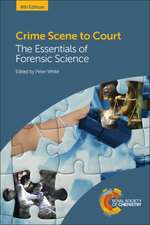Fisher's Techniques of Crime Scene Investigation First International Edition
Autor William J. Tilstone, Michael L. Hastrup, Camilla Halden Limba Engleză Hardback – 22 aug 2012
Barry Fisher‘s Techniques of Crime Scene Investigation has long been considered the "bible" of the crime-solving profession, drawing from the author‘s 40-year career in forensic science, including his time spent as the crime laboratory director for the Los Angeles County Sheriff‘s Department. Now for the first time, com
Preț: 1319.08 lei
Preț vechi: 1449.55 lei
-9% Nou
Puncte Express: 1979
Preț estimativ în valută:
252.41€ • 264.07$ • 209.67£
252.41€ • 264.07$ • 209.67£
Carte disponibilă
Livrare economică 13-27 martie
Livrare express 26 februarie-04 martie pentru 56.01 lei
Preluare comenzi: 021 569.72.76
Specificații
ISBN-13: 9781439817049
ISBN-10: 1439817049
Pagini: 502
Ilustrații: 264 colour illustrations, 20 black & white tables
Dimensiuni: 178 x 254 x 26 mm
Greutate: 1.18 kg
Ediția:1 International ed.
Editura: Taylor & Francis
Colecția CRC Press
Locul publicării:Oxford, United Kingdom
ISBN-10: 1439817049
Pagini: 502
Ilustrații: 264 colour illustrations, 20 black & white tables
Dimensiuni: 178 x 254 x 26 mm
Greutate: 1.18 kg
Ediția:1 International ed.
Editura: Taylor & Francis
Colecția CRC Press
Locul publicării:Oxford, United Kingdom
Public țintă
Crime scene investigation, forensic science, law enforcement, and criminal justice students and professionals in Europe.Cuprins
The Forensic Process, Principles, and Practice. Forensic Science and Evidence. The Investigative Star in Crime Scene Investigation. The Forensic Process: Performance, Practice, and Procedures of Scene Investigation. Practical Scene Investigation: The Body in the Woods. Practitioner Competency, Professionalism, and Codes of Conduct. Forms of Evidence, Identification, and Recovery. Establishing Personal Identity. Trace Evidence and Miscellaneous Materials. Forensic Biology. Impression Evidence. Firearms Examination. Arson and Explosions. Scene Investigation and Type Of Crime. Illicit Drugs and Toxicology. Investigating Sexual Assault. Burglary Investigation. Motor Vehicle Investigation. Homicide Investigation. Appendices. Bibliography. Index.
Notă biografică
William (Bill) Tilstone has a B.Sc. and a Ph.D. from the University of Glasgow. He spent seven years as a lecturer in the University‘s Department of Pathological Biochemistry, where his research on drug kinetics in overdose and on the biochemistry of the body‘s responses to major trauma led to his introduction to forensic science. He was a lecturer in forensic science at the University of Strathclyde, also in Glasgow, where he worked for 12 years and served as a professor and head of the Forensic Science Unit for six years. While at Strathclyde, he was actively involved in casework, mainly in forensic biology for the public prosecutor and in toxicology for the defence. Bill left his academic position to become the first director of the newly established Forensic Science Centre in South Australia, a position he held until 1996, when he accepted the position of Executive Director of the National Forensic Science Technology Center (NFSTC), in Florida. This history has given him a unique blend of experiences in forensic science, including practical casework, teaching, and research, as well as executive management in academia, government, and private business, covering three different countries. He has contributed more than 100 papers and reviews to the literature and two books in addition to the present work. After retiring from the NFSTC in 2007, he continues to serve as the quality manager and assessor for an American forensic accrediting body and has also maintained his academic links in Scotland.
Michael Hastrup began his investigation career in 1984 when he was employed as a police officer with the Danish National Police. This was followed by employment as a detective inspector before joining the National Centre of Forensic Services after nine years of service. He worked as a fingerprint examiner before moving to the Scene of Crime Section in Copenhagen, where he began his career as a crime scene investigator which con
Michael Hastrup began his investigation career in 1984 when he was employed as a police officer with the Danish National Police. This was followed by employment as a detective inspector before joining the National Centre of Forensic Services after nine years of service. He worked as a fingerprint examiner before moving to the Scene of Crime Section in Copenhagen, where he began his career as a crime scene investigator which con
Descriere
Barry Fisher‘s Techniques of Crime Scene Investigation has long been considered the "bible" of the crime-solving profession. Now oriented specifically to an international audience, this special edition focuses on international procedures, laws, and cases. The first section explores the forensic process and the basic principles of crime scene investigation. Next, the book covers trace and impression evidence, establishing personal identity, forensic biology, and evidence associated with firearms, arson, and explosions. Enhanced with hundreds of diagrams and color photos of actual crime scenes, the book concludes with chapters on the investigation of various crime scenarios.



















